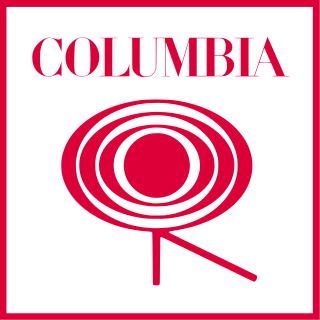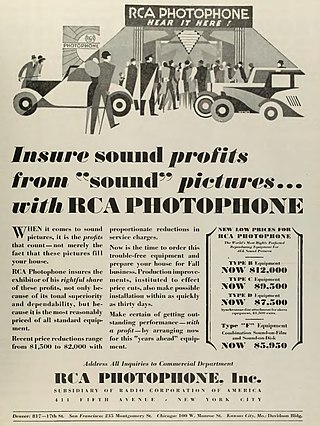Related Research Articles

Decca Records is a British record label established in 1929 by Edward Lewis. Its US label was established in late 1934 by Lewis, Jack Kapp and Milton Rackmil, who later became American Decca's president too. In 1937, anticipating Nazi aggression leading to World War II, Lewis sold American Decca, and the link between the UK and US Decca label was broken for several decades. The British label was renowned for its development of recording methods, while the American company developed the concept of cast albums in the musical genre.

Columbia Records is an American record label owned by Sony Music Entertainment, a subsidiary of Sony Corporation of America, the North American division of Japanese conglomerate Sony. It was founded on January 15, 1889, evolving from the American Graphophone Company, the successor to the Volta Graphophone Company. Columbia is the oldest surviving brand name in the recorded sound business, and the second major company to produce records. From 1961 to 1991, its recordings were released outside North America under the name CBS Records to avoid confusion with EMI's Columbia Graphophone Company. Columbia is one of Sony Music's four flagship record labels: Epic Records, and former longtime rivals, RCA Records and Arista Records as the latter two were originally owned by BMG before its 2008 relaunch after Sony's acquisition alongside other BMG labels.
RCA Records is an American record label owned by Sony Music Entertainment, a subsidiary of Sony Corporation of America.

Quadraphonic sound – equivalent to what is now called 4.0 surround sound – uses four audio channels in which speakers are positioned at the four corners of a listening space. The system allows for the reproduction of sound signals that are independent of one another.

Monaural or monophonic sound reproduction is sound intended to be heard as if it were emanating from one position. This contrasts with stereophonic sound or stereo, which uses two separate audio channels to reproduce sound from two microphones on the right and left side, which is reproduced with two separate loudspeakers to give a sense of the direction of sound sources. In mono, only one loudspeaker is necessary, but, when played through multiple loudspeakers or headphones, identical signals are fed to each speaker, resulting in the perception of one-channel sound "imaging" in one sonic space between the speakers. Monaural recordings, like stereo ones, typically use multiple microphones fed into multiple channels on a recording console, but each channel is "panned" to the center. In the final stage, the various center-panned signal paths are usually mixed down to two identical tracks, which, because they are identical, are perceived upon playback as representing a single unified signal at a single place in the soundstage. In some cases, multitrack sources are mixed to a one-track tape, thus becoming one signal. In the mastering stage, particularly in the days of mono records, the one- or two-track mono master tape was then transferred to a one-track lathe used to produce a master disc intended to be used in the pressing of a monophonic record. Today, however, monaural recordings are usually mastered to be played on stereo and multi-track formats, yet retain their center-panned mono soundstage characteristics.

Bluebird Records is an American record label best known for its low-cost releases, primarily of children's music, blues, jazz and swing in the 1930s and 1940s. Bluebird was founded in 1932 as a lower-priced subsidiary label of RCA Victor. Bluebird was noted for what came to be known as the "Bluebird sound", which influenced rhythm and blues and early rock and roll. It is currently owned by RCA Records parent company Sony Music Entertainment.

Sound-on-film is a class of sound film processes where the sound accompanying a picture is recorded on photographic film, usually, but not always, the same strip of film carrying the picture. Sound-on-film processes can either record an analog sound track or digital sound track, and may record the signal either optically or magnetically. Earlier technologies were sound-on-disc, meaning the film's soundtrack would be on a separate phonograph record.
Philips Records is a record label founded by the Dutch electronics company Philips and the Dutch-American largest record label company Universal Music Group. It was founded as Philips Phonographische Industrie in 1950. In 1946, Philips acquired the company which pressed records for British Decca's Dutch outlet in Amsterdam.

Stereophonic sound, or more commonly stereo, is a method of sound reproduction that recreates a multi-directional, 3-dimensional audible perspective. This is usually achieved by using two independent audio channels through a configuration of two loudspeakers in such a way as to create the impression of sound heard from various directions, as in natural hearing.
Dolby Stereo is a sound format made by Dolby Laboratories. It is a unified brand for two completely different basic systems: the Dolby SVA 1976 system used with optical sound tracks on 35mm film, and Dolby Stereo 70mm noise reduction on 6-channel magnetic soundtracks on 70mm prints.

RCA Photophone was the trade name given to one of four major competing technologies that emerged in the American film industry in the late 1920s for synchronizing electrically recorded audio to a motion picture image. RCA Photophone was an optical sound, "variable-area" film exposure system, in which the modulated area (width) corresponded to the waveform of the audio signal. The three other major technologies were the Warner Bros. Vitaphone sound-on-disc system, as well as two "variable-density" sound-on-film systems, Lee De Forest's Phonofilm, and Fox-Case's Movietone.
RCA Camden was a budget record label of RCA Victor, originally created in 1953 to reissue recordings from earlier 78rpm releases. The label was named "Camden", after Camden, New Jersey where the offices, factories and studios of RCA Victor and its predecessor, the Victor Talking Machine Company had been located since 1901.
David Leonard Miller was an American record producer and the founder of many budget album record companies. Miller is more familiar to some record buyers and collectors as the notorious Leo Muller who produced many Exploito type records.

Canned Wheat is the fifth studio album by Canadian rock band the Guess Who, released in September 1969. It peaked at number 91 on the Billboard Pop Albums chart. Two of the band's hits were taken from the album: "Laughing" and "Undun". The album also includes a version of "No Time" which would later be re-recorded for their American Woman album and released as a single. The album is regarded as a rock classic.
Budget albums were low-priced vinyl LPs of popular and classical music released during the 1950s to 1970s consisting either of previously released material or material recorded especially for the line. Prices ranged from as low as 59 U.S. cents to $2.98. In the UK Pickwick Records' Top of the Pops record series, which operated between 1968 and 1985, was the most successful budget album range.
Audiophile Records is a record company and label founded in 1947 by Ewing Dunbar Nunn to produce recordings of Dixieland jazz. A very few of the early pressings were classical music, Robert Noehren on pipe organ, AP-2 and AP-9 for example.

Quadraphonic Sound was a phase amplitude matrix 4-channel quadraphonic sound system for phonograph records. The system was based on technology created by Peter Scheiber, but further developed by engineer Ryosuke Ito of Sansui in the early 1970s.

Compatible Discrete 4, also known as Quadradisc or CD-4 was a discrete four-channel quadraphonic system for phonograph records. The system was created by JVC and RCA in 1971 and introduced in May 1972. Hundreds of recordings using this technology were released on LP during the 1970s.
Stereo-4, also known as EV or EV-4, was a matrix 4-channel quadraphonic sound system developed in 1970 by Leonard Feldman and Jon Fixler.

UD-4 was a discrete four-channel quadraphonic sound system for phonograph records introduced by Nippon Columbia (Denon) in 1974. This system had some similarities with the more successful CD-4 process introduced by JVC and RCA in 1972.
References
- ↑ WHO'S WHO IN A&R AT OVATION
- ↑ "Ovation Records". 43 North. Retrieved August 30, 2022.